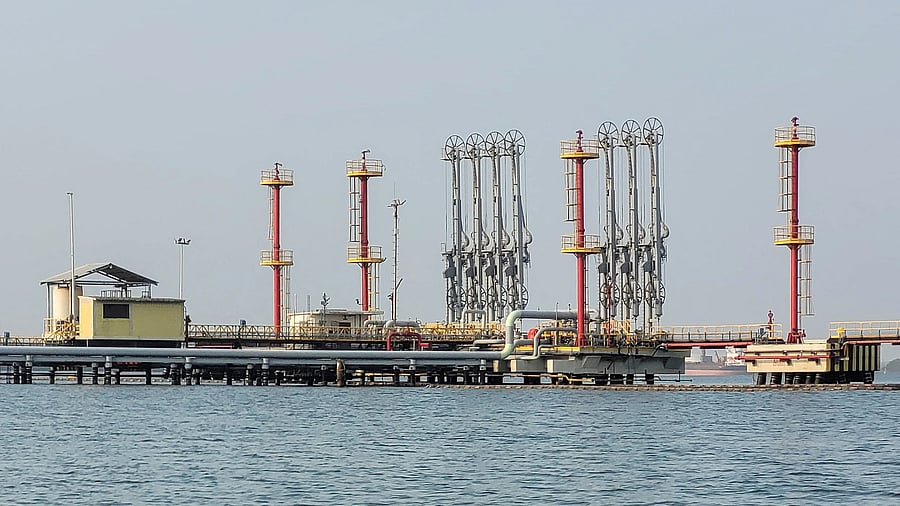
A complex of pipes used for the export of crude oil in a dock.
Credit: Reuters Photo
Houston: US crude oil exports eased in July to the lowest levels in nearly four years on low domestic supplies and as Asian and European buyers found cheaper alternatives, undermining U.S. President Donald Trump's push for more foreign countries to purchase U.S. energy supplies.
The decline in exports from the top global producer underscores the extent to which oil flows are dictated by price and the economics of shipping, even as the Trump administration recently has pushed countries to commit to more U.S. oil purchases as part of trade negotiations.
U.S. crude exports tumbled to about 3.1 million barrels per day (bpd) in July, the lowest since October 2021, when the Covid-19 pandemic ravaged demand, according to data from ship tracking firm Kpler.
Exports averaged 3.2 million bpd over the last five weeks, compared with 3.6 million bpd in June, according to the US Energy Information Administration.
The decline came as the spread between European and U.S. benchmark crude futures narrowed, making it less economically attractive to ship barrels across the Atlantic.
"Markets are driven by economics, and companies are driven by profits, and so companies are going to continue to purchase what is the cheapest or the best feedstock for them," said Matt Smith, lead oil analyst at Kpler. "There's a very, very incremental impact (from trade agreements on U.S. crude exports), but it's not going to move the needle," Smith added.
WTI's discount to Brent <WTCLc1-LCOc1> in May and June, when oil delivered in July is traded, averaged about $3 a barrel, well above the $4 discount that typically encourages foreign countries to buy U.S. oil.
"There's just not the incentive there to be pushing those barrels out. They're more needed at home than they are abroad," said Smith. Exports of U.S. crude to Asia fell to 862,000 bpd in July, the lowest since January 2019, and well below the three-month average of 1.1 million bpd, Kpler data showed.
China, the world's top oil consumer, took no barrels for the fifth straight month as trade tensions continued between the two countries, while shipments to South Korea, the second largest buyer of U.S. crude in 2024, nearly halved in July, and those to India fell 46%.
Meanwhile, exports to Europe fell 14% to 1.6 million bpd from June. Inventories of oil at the key storage hub in Cushing, Oklahoma, hovered just above operational levels, amid lower Canadian oil flows due to a wildfire and last year's Trans Mountain pipeline expansion.
That kept more domestic barrels in the U.S., traders and analysts said. Prices for WTI Midland at Cushing were about 40 cents higher than prices for it along the Gulf coast, said Jeremy Irwin, global crude lead at Energy Aspects. Higher U.S. refining activity also encouraged some barrels to stay locally, Irwin said.
Exports of Canadian crude from the U.S. Gulf Coast also eased 31% to 78,000 bpd in July, as U.S. refiners snapped up the barrels to replace lower Venezuelan and Mexican imports.
Short-lived rebound seen
Exports to Asia of U.S. crude are expected to step up in the fourth quarter as Middle East oil prices strengthened, making it more economic to ship oil to Asia from the U.S., trade sources said last week.
Energy Aspects forecast about a 400,000-bpd increase to August from July in U.S. Gulf Coast exports.
While Washington's push for countries to commit to energy purchases as part of trade deals may help inch exports higher in the short term, traders and analysts remained skeptical of any longer-term boost to exports from the agreements.
South Korea said it would purchase $100 billion worth of liquefied natural gas or other energy products, while the European Union pledged to buy $250 billion of U.S. energy supplies per year.
Pakistan is set to import its first-ever cargo of U.S. crude in October, while India's biggest refiner Indian Oil Corp bought 4.5 million barrels of U.S. crude this week as Trump threatens tariff hikes on the country for its purchases of Russian oil.
Purchases from trade deals would likely only push up U.S. exports for two or three months, said Jeremy Irwin, global crude lead at Energy Aspects.
Further, rising OPEC+ supplies especially into the end of the year are set to increase options for European and Asian refiners, and could weigh on export demand for light sweet U.S. crude.
The group agreed on Sunday to raise oil production by 547,000 bpd for September, marking a full and early reversal of its largest tranche of output cuts.